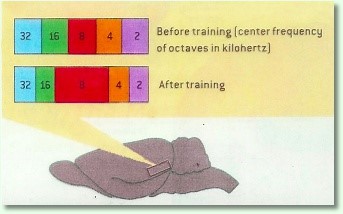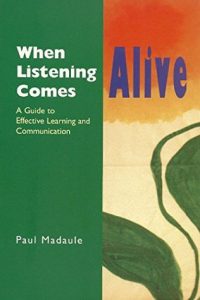 Dr. Tomatis knew that our brain has an extraordinary capacity to adapt and therefore to learn. It is the brain’s ability to be plastic, a characteristic called neuroplasticity, that facilitates new-learning or re-learning after an injury. A French ENT and surgeon, Alfred Tomatis followed exactly this long-known fact as he developed the Tomatis Method of sound stimulation. From learning a new skill or retaining information, (short- and long-term memory) to being able to anticipate and plan (executive functioning) our brain-plasticity is what is being shaped through repeated stimulation or practice. New connections between individual and groups of neurons as well as between various processing centers (neural networks) in the brain are being shaped in the process of adequate, specific and systematic stimulation. “Neurons that fire together wire together” a phrase coined by the Canadian neuropsychologist Donald Hebb in the late 1940s captures the complex process of neuro-plasticity in a few words, must have been known to Tomatis.
Dr. Tomatis knew that our brain has an extraordinary capacity to adapt and therefore to learn. It is the brain’s ability to be plastic, a characteristic called neuroplasticity, that facilitates new-learning or re-learning after an injury. A French ENT and surgeon, Alfred Tomatis followed exactly this long-known fact as he developed the Tomatis Method of sound stimulation. From learning a new skill or retaining information, (short- and long-term memory) to being able to anticipate and plan (executive functioning) our brain-plasticity is what is being shaped through repeated stimulation or practice. New connections between individual and groups of neurons as well as between various processing centers (neural networks) in the brain are being shaped in the process of adequate, specific and systematic stimulation. “Neurons that fire together wire together” a phrase coined by the Canadian neuropsychologist Donald Hebb in the late 1940s captures the complex process of neuro-plasticity in a few words, must have been known to Tomatis.
Dr. Tomatis who followed his own observations in addition to contemporary research of the brain’s functioning dedicated his life to being a researcher, inventor and clinician in the field he created: Audio-Psycho-Phonology. Systematic sound-stimulation can reshape various functions: from the ear-brain connection to the integration of other sensory systems and their contribution to a thought formation, a motor action or an emotional response (information processing). For instance, we can suddenly learn to dance to the beat with ease instead of remaining clumsy and behind on the rhythm; this ability can only occur, when auditory-vestibular processing becomes efficiently integrated and timed. A systematic sound stimulation program can be one avenue to attain a high degree of quick and accurate processing. Our visual and auditory information could also become more readily integrated; Thus, we can easily look and listen while also noticing the speaker’s non-verbal signals as part of a highly skilled social communication capacity.
Our ability to read and comprehend with higher accuracy and speed is equally affected by an exquisite integration of these two systems (auditory and visual) along with vestibular (balance) regulation which in turn affects our muscle tone response. When those functions are not fully developed and integrated such as in Dyslexia, a specific Learning Disability (LD), Attention Deficit Disorder, etc. we are not able to perform many skills with the ease we wish. People who have been affected by a traumatic brain injury (TBI) may also be unable to perform the numerous skills associated with appropriate functioning and communication. Neuroplasticity, however, the brain’s ability to change and learn supports the fact that both, children and adults can learn or retrain a multitude of skills. This is where a sound stimulation approach comes into place.
More recently Norman Doidge, MD dedicated a whole chapter to Dr. Tomatis’ method of sound stimulation in his newest book about neuro-plasticity: “The Brain’s Way of Healing”. In his interview with Paul Madaule, psychologist and director of the Listening Centre in Toronto, Dr. Doidge draws from Paul’s own experience with the Tomatis’ Method as a teenager with dyslexia who has been greatly helped by Dr. Tomatis. Paul Madaule soon became one of Tomatis’ early disciples; Dr. Doidge engages Paul’s vast experience of 40 years with this approach as a clinician in sharing how re-shaping neural connections can help develop or regain skills and functions. Paul Madaule’s experience working with children and adults in his full-time Centre is unparalleled. He is witness to how his professional expertise (as a psychologist) in human development and systematic work with sound-stimulation is an avenue for many people who are seeking to develop or perfect skills in listening, attention, motor functions and cognitive learning to emotional regulation.

Paul Madaule, 1994
Paul Madaule’s book “When Listening Comes Alive” gives a unique perspective from more than one point of view: that of his own story as a teenage client – when he fortunately met Dr. Alfred Tomatis who treated and inspired Paul to succeed in school and in life – . In his writing Paul also shares his valuable insights from a clinician’s perspective – that of psychologist who has used the sound-approach helping thousands of children and adults at his Listening Centre in Toronto. His recently revised book has a foreword by Norman Doidge, M.D., author of The Brain That Changes Itself and The Brain’s Way of Healing.
